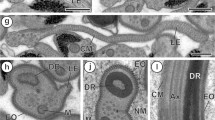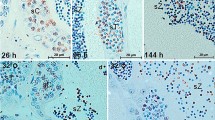Abstract
STUDIES on the spermatogenesis of Asellus aquaticus L.1 directed attention to the polyploid cells surrounding each testicular lobe. It has been found that these cells show cyclic variations of morphological characters both in nucleus and in cytoplasm which correspond to different phases of spermatocytic evolution. The latter is almost synchronous in each lobe, and a small bunch of spermatogonia remains in the basal portion of the lobe, to ensure the next spermatogenetic wave.
Similar content being viewed by others
References
Vitagliano, G., Pub. Staz. Zool. di Napoli, 21, 164 (1947).
Geitler, L., Ergeb. d. Biol., 18, 1 (1944).
Brachet, J., and Jeener, R., C.R. Soc. Biol., 140, 1121 (1946).
Jeener, R., Actual. Biochim. (Désoer, Liège), No. 10, 88 (1947).
Montalenti, G., and de Nicola, M., Experientia, 4, 315 (1948).
Painter, T. S., and Reindorp, E., Chromosoma, 1, 276 (1939).
Painter, T. S., Bot. Gaz., 105, 58 (1940).
Author information
Authors and Affiliations
Rights and permissions
About this article
Cite this article
VITAGLIANO, G., DE NICOLA, M. Ribonucleic Acid Supply and Phosphatase Distribution during the Spermatogenesis of Asellus aquaticus. Nature 162, 965–966 (1948). https://doi.org/10.1038/162965b0
Issue Date:
DOI: https://doi.org/10.1038/162965b0
- Springer Nature Limited
This article is cited by
-
Untersuchungen �ber die Degeneration samenbildender Zellen in der normalen Spermatogenese der Ratte
Zeitschrift f�r Zellforschung und Mikroskopische Anatomie (1954)
-
The supply of ribonucleic acid to the male germ cells during meiosis in Asellus aquaticus
Heredity (1950)
-
Cellula apicale e metabolismo degli acidi nucleici nella spermatogenesi degli Ortotteri(Acrididae e Locustidae)
Experientia (1949)





